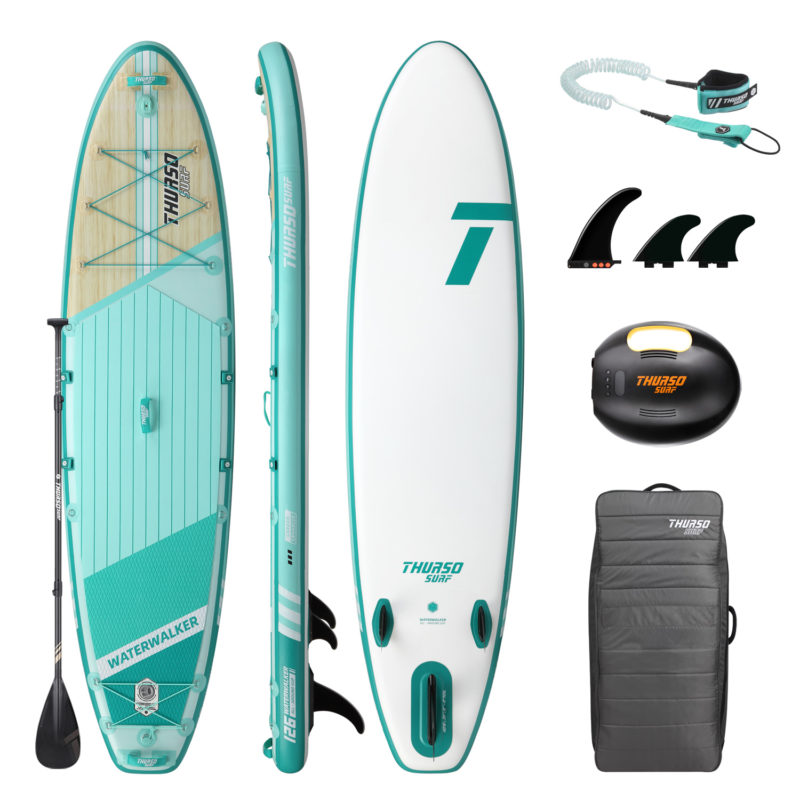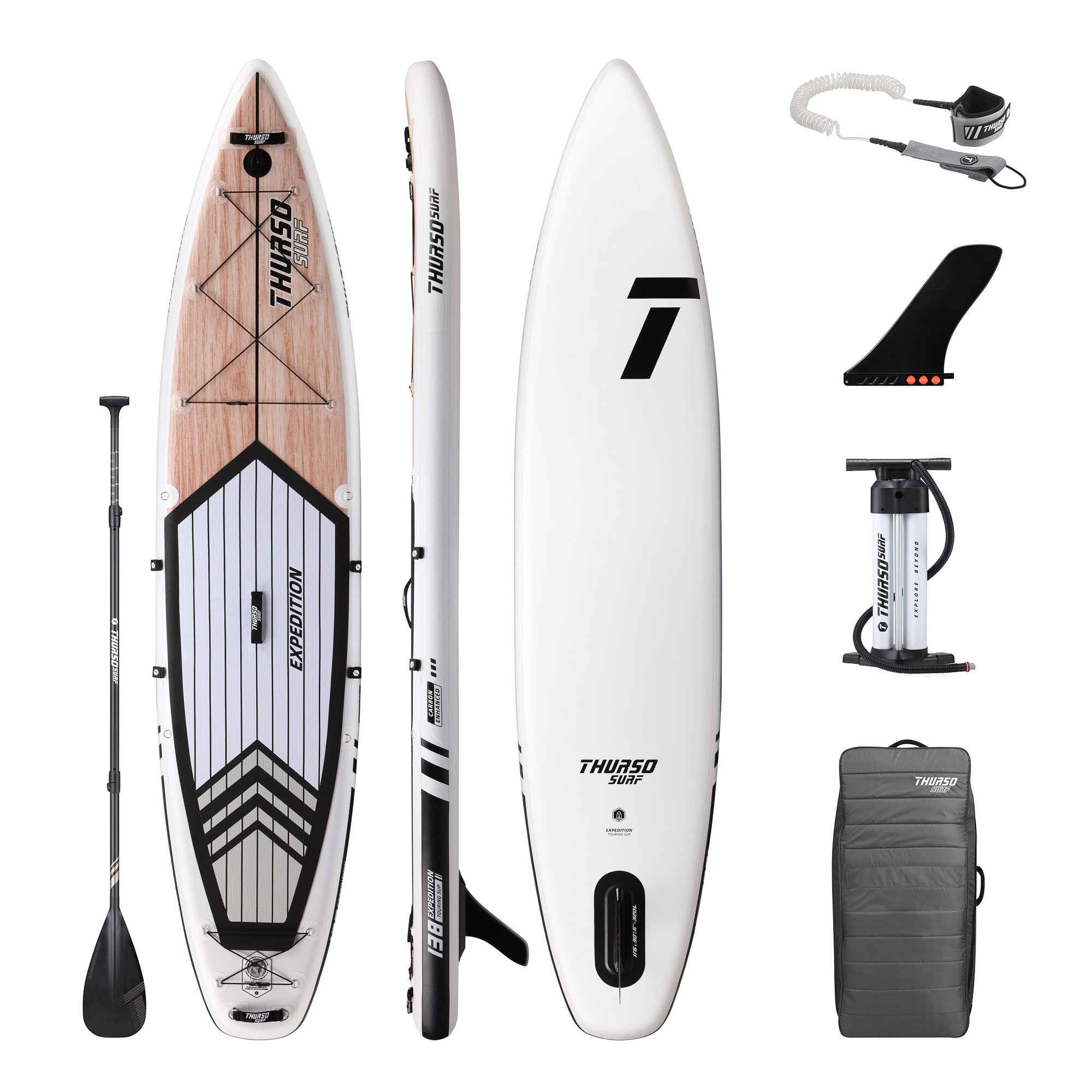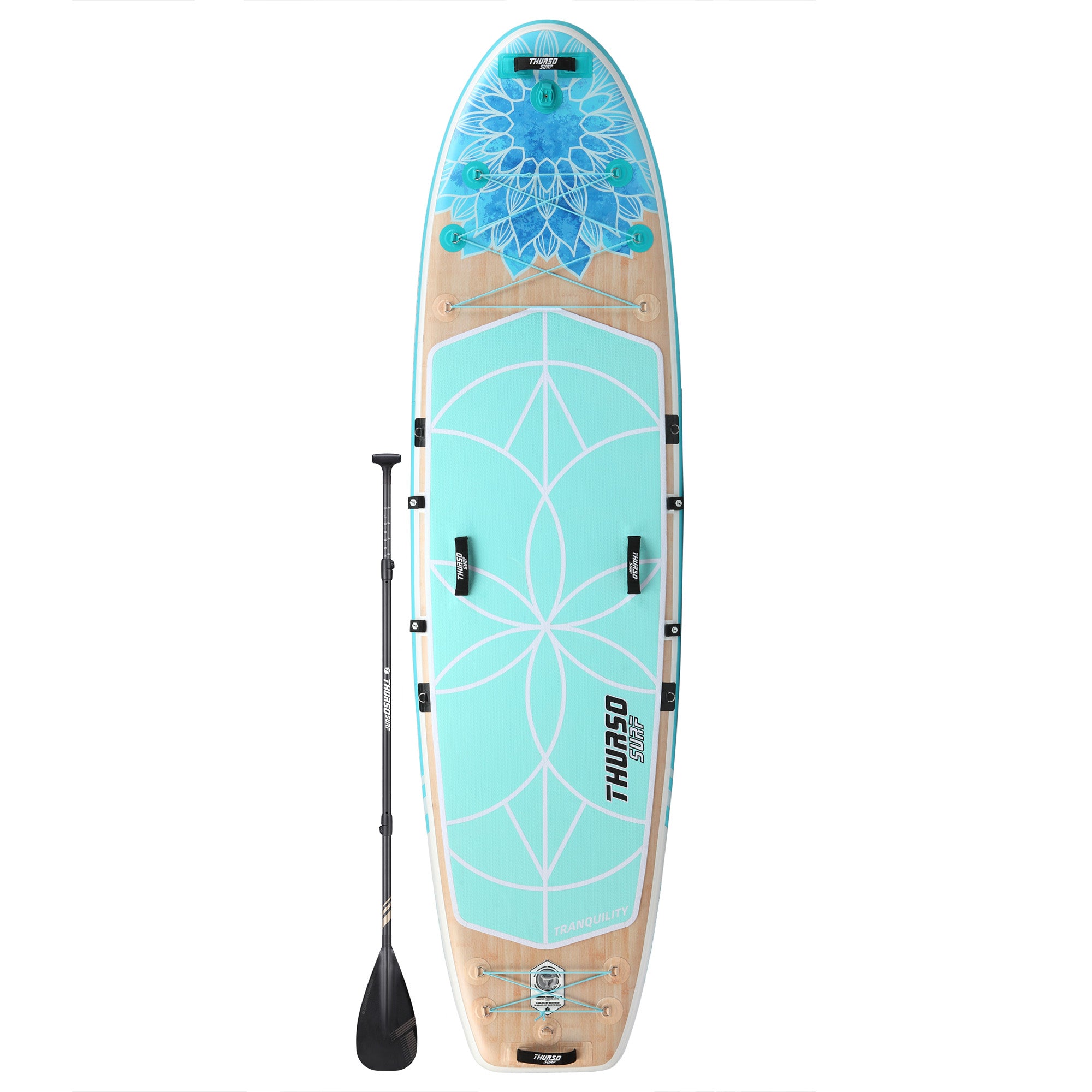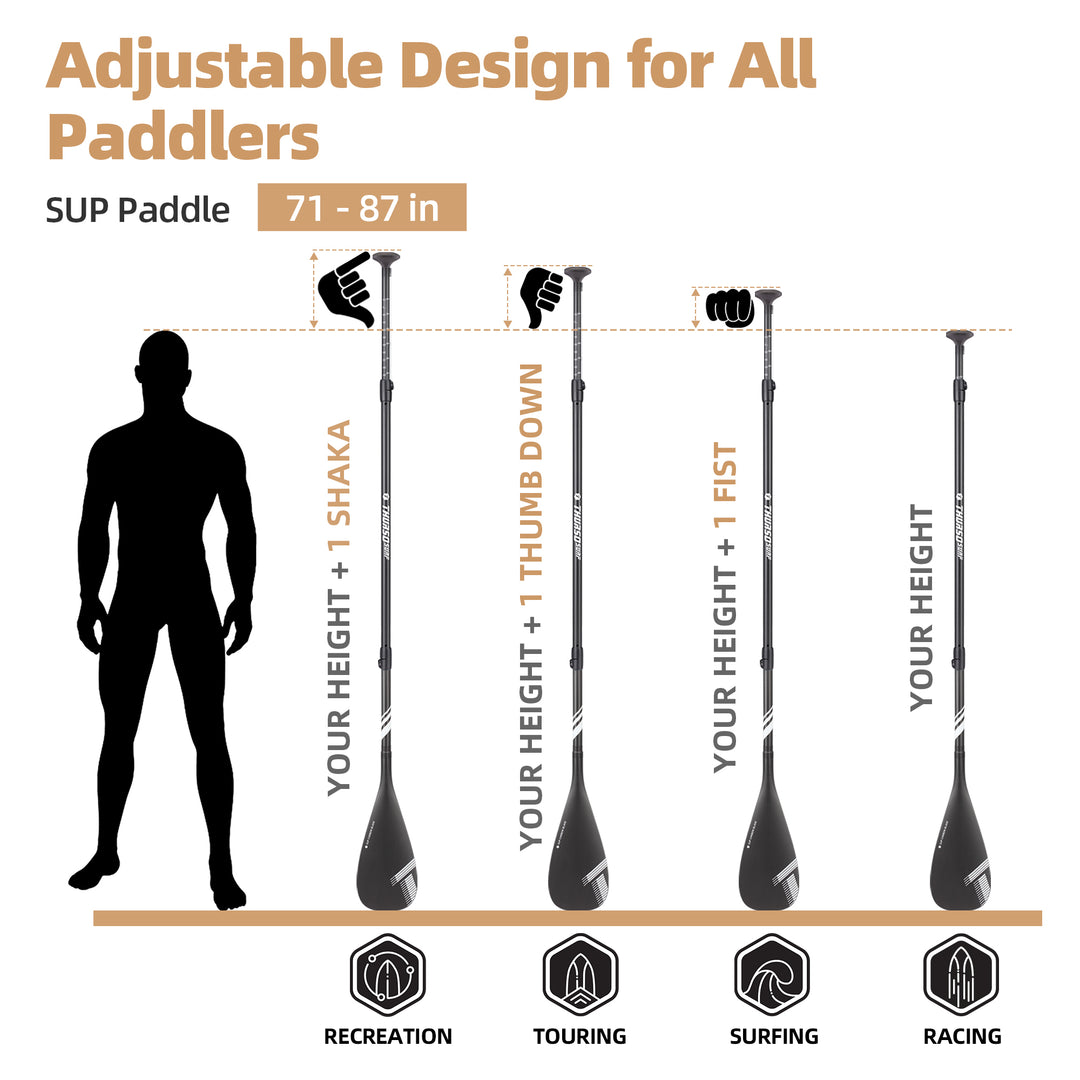With the global boom in water sports, the stand-up paddleboard (SUP) has become an excellent choice for summer vacations and everyday leisure activities. However, the huge selection of SUP boards on the market—from shape and size to the huge price differences—can quickly overwhelm beginners. Have you ever wondered why some SUPs cost as little as €300 while others cost as much as €1,400? What are the differences between budget boards and premium brands?
Below, I will unravel these mysteries for you and help you find the perfect SUP board that suits you best.

Which SUP shape suits me best?
Before choosing a SUP type, you should first clearly define your intended use. Stand-up paddleboards can be roughly divided into the following main types, each of which offers its own advantages:
1. All-round/Freestyle SUP: The ideal choice for beginners
These SUP boards are wide and have a flat bottom, making them particularly easy to handle. Their larger surface area provides excellent stability, helping you quickly find your balance. Whether it's a calm lake, inland waters, or slightly undulating ocean surface, all-around boards handle all conditions with ease.
Not only are they beginner-friendly, they're also perfect for the whole family. Even experienced paddlers looking for a comfortable and relaxed ride appreciate these boards.
SUP all-round board
2. Touring board: The perfect combination of speed and stability
As the name suggests, this board is the ideal choice if you want to go touring with your SUP. Compared to the all-round board, the touring board is slightly narrower but longer, and the tip is more pointed.
This streamlined design allows for faster progress on the water. These boards are preferred by sporty paddlers who often cover long distances. Even experienced riders enjoy touring boards on rivers for an exciting experience.
The touring board is the perfect compromise between an all-rounder and a racing board – if you're looking for a SUP that's fast, stable, and suitable for lightly choppy water, you won't be disappointed with a touring board.
Touring board
3. Race Board: The professional choice for speed lovers
The race SUP is a further optimized version of the touring board—narrower, pointier, and longer. This results in less stability, making it difficult to handle, especially for beginners, and less fun.Thanks to its extremely sleek shape, the race board achieves unparalleled speeds on the water, but is also more susceptible to swaying. Especially in larger waves or small surf, even an experienced paddler can easily lose their balance.
We recommend race boards exclusively for experienced riders with sporting ambitions. While touring boards are somewhat slower, they offer significantly more comfort and stability.
4. Yoga SUP board: The ideal platform for meditation on the water
Yoga SUP boards are wide and comfortable, similar to all-around boards, and combine stability with good maneuverability. If you want to add a new dimension to your yoga practice or simply enjoy the joy of yoga in a refreshing aquatic environment, a yoga SUP is definitely a worthwhile investment.
Professional yoga boards are usually equipped with a particularly soft EVA mat (similar to a yoga mat) and a practical paddle holder. With a yoga SUP, you can float and relax along the lakeshore or coastline.
However, if you plan to cover longer distances, we still recommend a touring board.
5.Special SUP boards for children: Custom-made, smaller versions
The impact of a SUP board's volume on the user experience is often underestimated. For children and smaller paddlers, a board that's too large can significantly impair performance and limit maneuverability. Smaller users often have difficulty guiding the paddle into the water without changing their stance on both sides. For this reason, some manufacturers have developed special SUP boards that are tailored to children in terms of size and volume. These children's boards are more compact and have a reasonable width, allowing children to paddle comfortably and effortlessly.
SUP board for children
6. Multifunctional windsurfing SUP board: The smart choice for two applications
Is it possible to windsurf with a SUP board? The answer is yes! Multifunctional SUPs with a windsurfing option allow you to go from stand-up paddling to windsurfing in just a few minutes. Conditions on the water change frequently, and anyone who has paddled against the wind in force 2-3 winds knows how exhausting it can be. With a SUP with a windsurfing option, you don't have to worry about changes in wind direction; you can simply quickly set up the sail, and the new fun begins immediately! We especially recommend this multifunctional SUP for windsurfing beginners, recreational sailors, and parents who want to introduce their children to wind sports without having to invest in complete equipment.

SUP seats and kayak paddles: Variety in play Some SUP manufacturers offer optional
We offer kayak seats that are easy to mount on your SUP board. These seats attach to the board via additional or existing D-rings, allowing you to switch from stand-up paddling to sit-down paddling. Of course, you'll also need a kayak paddle so you can move comfortably without having to constantly switch sides. This configuration is especially suitable for those who want to relax occasionally while stand-up paddling, or for beginners who have trouble maintaining their balance on the SUP. On sunny days, you can carry a magazine in a waterproof bag or cast your fishing rod—these are great ways to spend a relaxing time on the water.
Structure and design of inflatable SUP boards: The key to quality
The structure and technical details of a SUP board largely determine its price and weight. At first glance, many boards appear very similar—which is precisely what makes choosing the right SUP so challenging. However, those who take the time to examine these details more closely will be rewarded with a significantly better experience on the water in the long run.
While the quality of the SUP's internal connecting threads can't be directly verified (unless noticeable dents appear during initial inflation—in which case, the board should be returned immediately), there's no need to worry: Almost every inflatable SUP has a small dent on the back of the valve. These connecting elements—called drop stitch threads—hold the top and bottom of the board together and ensure it maintains its ideal shape.
For this reason, the areas opposite the inlet valve are often somewhat uneven, as drop stitch material cannot be used in these areas. A few years ago, the valve was usually located at the rear of the SUP (near the fin box), making these irregularities barely visible. However, practical experience has shown that a valve at the front of the board significantly simplifies folding and storage.
Single layer, double layer, glued or fused: differences in material technology
Given the materials currently used, I strongly advise against choosing a single-layer inflatable SUP. Such boards generally lack the necessary rigidity and therefore don't provide a satisfying paddling experience.
When it comes to double-layer SUPs, it's important to distinguish between glued and fused technology. As the name suggests, glued double-layer boards are bonded together with chemical adhesives. This process is not only environmentally harmful but also significantly increases the weight of the board. Compared to a fused double-layer model, the weight difference can be 5 kg or more.
Fused double-layer SUPs, on the other hand, are welded together using high-pressure, high-temperature technology – completely without adhesive. This makes them not only lighter but also significantly more environmentally friendly. This fused material is typically used for the deck (top) and bottom. However, it's important to note that almost all manufacturers still use adhesive to join the edges (rails) of the SUP.
If you're looking for a high-quality inflatable SUP board, you should definitely choose a model with a fused double-layer construction. This decision will guarantee you many years of stand-up paddling enjoyment!
Choose SUP volume (size): Closely related to body weight
Choosing the right volume for a stand-up paddleboard depends primarily on the paddler's body weight. Generally speaking, the lighter the person, the smaller the volume of the SUP board should be. Here's a basic sizing guide for inflatable SUP boards:
The volume of an iSUP (inflatable SUP) cannot be directly compared to that of a hardboard or windsurfing board – the latter generally have significantly smaller volumes. The main difference lies in the design of the rails (edges): While hardboards may have clearly defined edges and varying thicknesses at the nose, middle, and tail, inflatable SUPs maintain a uniform thickness across their entire length. For this reason, iSUPs of the same length usually have a significantly larger volume than traditional SUPs.
A proven guideline for the ideal board size is:
Body weight × 2 (for advanced) or
Body weight × 2.5 (for beginners) .
A SUP board whose volume is adjusted to your weight responds much more precisely to steering impulses and ensures stable handling.
If, on the other hand, you choose a board that is too big for your weight, it can be susceptible to crosswinds and appear unstable due to the raised water position - which has a negative effect on the riding experience.
Price guide for SUPs: How much does a good entry-level board cost?
As already mentioned, the price range for SUP boards ranges from a few hundred to over a thousand euros. A high-quality inflatable SUP for beginners should generally cost around 450 euros —that's a fair guideline!
For iSUPs (inflatable SUPs), stiffness is a crucial quality factor. It determines how much the board flexes under load—which has a long-term impact on performance and ride feel.
Unfortunately, the stiffness of a board can't usually be assessed visually or haptically before purchase. This also explains the sometimes significant price differences between products. High-quality SUPs are generally stiffer, allowing them to be built thinner , which in turn reduces volume and allows for a more agile paddling experience. Thanks to the better materials, such boards are also lighter and more efficient on the water.
I strongly advise against buying a SUP under €450 that's less than 6 inches (approx. 15 cm) thick. Cheap manufacturers usually can't guarantee sufficient stability at this thickness.
The only exception is children's models. Due to their lower body weight, a thickness of 4 inches (approx. 10 cm) is usually sufficient for children.
| criterion | Recommendation |
|---|---|
| Board type | Prefer all-round or touring board |
| material | Double-walled Fusion construction for optimal rigidity |
| thickness | 6 inches for adults, 4 inches for children |
| fin system | Removable US box system recommended |
| budget | Minimum recommended price: from 450 euros |
| Extras | Optional: Seat, windsurfing options, luggage net etc. as required |
SUP fin: Removable or permanently installed?
You may have already noticed: Inflatable SUPs are available with different fin systems. Basically, there's a distinction between a removable single fin (US box or slide-in system) and the so-called thruster setup , consisting of a large center fin and two smaller side fins.
Some manufacturers use a hybrid solution: The center fin is removable, while the smaller side fins are permanently attached to the board and fold when rolled up. Although these rubber fins are not damaged, they can bend in the SUP transport bag. This can lead to reduced directional stability during the next use.
This may be a disadvantage for ambitious paddlers – however, recreational paddlers who are primarily looking for fun on the water will hardly notice this difference.
US Box vs. Slide-In Fin System – A Comparison
The US box fin system originated in surfing and was later used in windsurfing. Today, it is also used on many inflatable SUPs. Similar to the slide-in system, the fin can be installed without tools.
The key difference between the two systems lies in the availability of replacement and tuning fins . Since the US Box system has been established on the market for many years, a wide selection of differently shaped fins is available – ideal for paddlers who want to customize their setup.
In contrast, the slide-in system offers only a very limited selection of compatible fins. However, if you don't plan on making any modifications to the original fin, this difference can be safely ignored.
Hardboard or iSUP? The right choice depends on the use
The first stand-up paddleboards were all hardboards, made of solid materials. But with technological advances in recent years, inflatable SUPs (iSUPs) have made the sport accessible to the masses.
iSUPs offer many advantages : They can be rolled up compactly, fit in the trunk of a car, or can even be taken on an airplane as luggage. They are also significantly more resistant to scratches and dents than hardboards.
These days, SUP enthusiasts can be seen everywhere on Europe's waters—especially on rivers and along the calm Mediterranean coasts. Inflatable boards are ideal for calm waters . Of course, there are performance differences between hardboards and iSUPs : Those living directly on the surfy coast might prefer a traditional hardboard.
However, for most recreational athletes who simply want to spend relaxing hours on the water, a lightweight, space-saving iSUP is the ideal choice. The slight difference in performance is usually more than offset by the enormous advantage in transport .
👉 Tip: Want to know how to properly care for your iSUP to extend its lifespan? Then read our SUP care guide with lots of practical tips!
iSUP vs. Hardboard: Which SUP is right for you?
| Comparison criterion | Inflatable SUP (iSUP) | Hardboard SUP |
|---|---|---|
| Transport & Storage | Compact roll-up, easy to transport | Requires roof rack or plenty of storage space |
| Shock resistance | Robust material, shock and scratch resistant – ideal for beginners | More sensitive to scratches and dents |
| Driving characteristics | Slightly less direct driving experience | Precise handling, high reaction speed |
| Target group | Perfect for leisure and occasional users | Suitable for ambitious paddlers |
Conclusion:
If you're not a professional SUP surfer, I definitely recommend an inflatable SUP . It's lightweight, practical, and offers the best overall package for most users .
Choosing a SUP paddle: How to decide on your perfect paddling experience
SUP paddles vary greatly in weight and price – but when buying, you should first consider their function. The size and shape of the paddle blade are crucial. The material of the blade and shaft are equally important, as they determine the weight, flexibility, and power transfer while paddling. Don't forget to choose a suitable paddle protector – especially if you have a fragile carbon paddle.
Want to learn more about different SUP paddles and the influence of paddle blade shape? Check out our comprehensive guide!
Start your SUP adventure now!
After this comprehensive guide, are you ready to find your perfect SUP board? Our online shop offers a wide selection of high-quality SUP boards – from versatile all-rounders for beginners to professional racing boards.
Why you should buy from us:
-
Professionally selected premium products
-
Strict quality controls on every board
-
Detailed instructions and clear video tutorials
-
2-year warranty and 30-day satisfaction guarantee
Visit our SUP shop now or contact our experts for personalized advice. Take advantage of our current discounts and secure your dream board – order now!
Frequently Asked Questions (FAQ)
-
Which SUP is best for beginners?
For SUP beginners, all-around boards or wide, stable touring boards are the best choice. These designs are easier to learn and offer better balance. -
What size should my SUP be?
This depends primarily on the user's weight, skill level, and intended use. For adult beginners, a SUP length between 10'6" and 12'6" is generally recommended. -
Hardboard or inflatable SUP – which is better?
For most recreational surfers, an inflatable SUP offers greater portability and practicality. Hardboards are more suitable for professional surfers or those seeking maximum performance. -
Are touring boards also suitable for SUP beginners?
Beginners with some athletic talent can usually find their way around touring boards. These boards offer a good balance between speed and stability. -
How much should my budget be for buying a SUP?
In the price range of €500 to €1,500, you can find products with very good value for money. Products below this price range usually compromise on material quality and performance.










